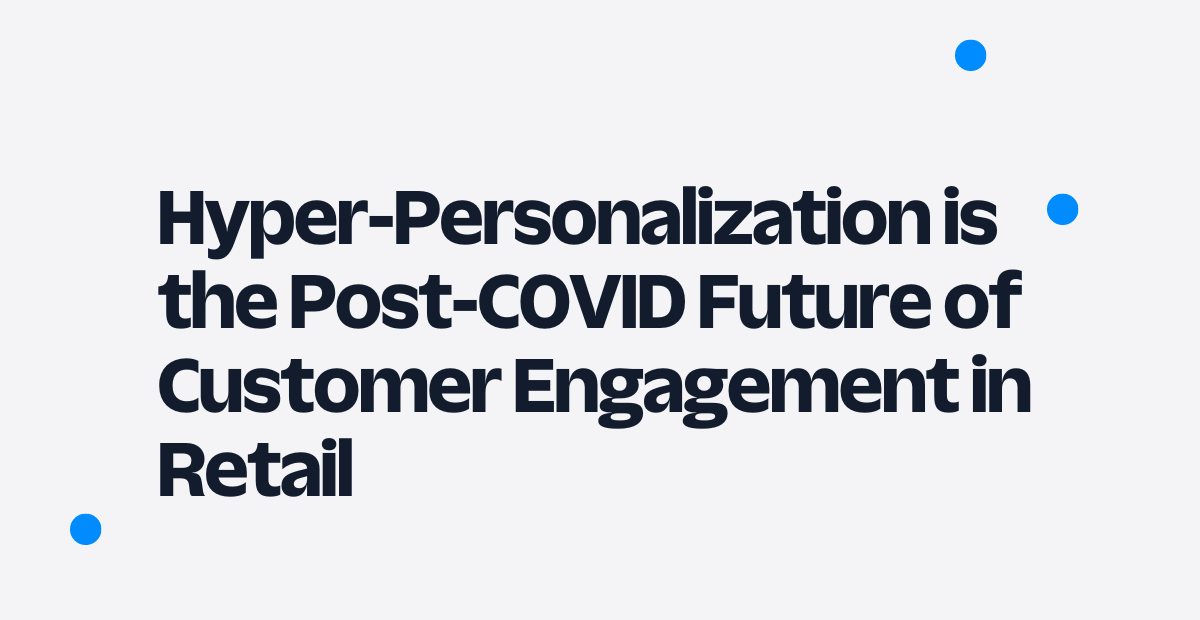Hyper-Personalization is the Post-COVID Future of Customer Engagement in Retail
Time to read: 3 minutes

The past year has tested every industry, and retail in particular has proven resilient. As companies emerge from the “just survive” triage period and look to define their futures, the brands leading the way in customer engagement will continue the “adapt and respond” approach that served them throughout the pandemic. By doing so, they’ll be best positioned to respond to ongoing shifts in consumer preferences as the pandemic continues and eventually, hopefully, resolves.
Personalization—but better
Offering a personalized shopping experience used to be the forefront of retail. Now, it’s table stakes.
The concept of personalization is not new for most retailers; most already personalize content and offers for their segmented cohorts. That said, the majority have not yet tapped the full potential that comes with hyper-personalization in retail.
Now’s the time: consumers’ benchmarks for great retail experiences are now higher than ever, since 72 percent of consumers only engage with marketing messages that are customized to their specific interests.
To stand out in an increasingly digitally saturated market, hyper-personalization is the inevitable future of retail. It allows brands to deeply understand the true needs and wants of their buyers, using real-time data in addition to other sourced customer data to enhance relationships, foster customer loyalty, and positively impact the bottom line.
Ninety one percent of consumers say they are more likely to shop with brands that provide offers and recommendations that are relevant to them. It’s clear: customizing engagement, product offerings, content. and experiences in real time is the way to recognize each one of your customers as unique individuals.
From personalization to hyper-personalization: A how-to guide
To help brands better assess and improve their approach to hyper-personalization, we recently published a 3 step guide on how to begin hyper-personalizing customer engagement in retail, focusing on how to grow from trend analysis and customer behavioral analysis to offer personalized customer experiences.
The guide breaks down the steps to achieving hyper-personalization in retail into the following:
- Begin with the voice of the customer.
- In an increasingly digital world, many customers find phone calls surprisingly effective and comforting. In fact, retail engagements typically begin with a high percentage of voice interactions with their customers. Learn how to start your Voice of the Customer transformation.
- End siloed engagements.
- As you begin collecting data, it’s important to implement methods to categorize the engagements per context. You can break the silos of information by categorizing the objective of an interaction i.e., conversations about a defective product, repeat purchase, clienteling, product questions or support.
- Orchestrate and hyper-personalize.
- Delivery of personalized content happens through a central source of truth and is activated based on consumer traits, frequency, and governed for consent and consistency on customer segmentation.
Hyper-personalization means going beyond just addressing your customer by name or sending them product recommendations based on search history alone. With hyper-personalization, each interaction is the result of the understanding of a variety of data points that retailers have available to them.
It’s up to you
In general, the majority of shoppers want brands to be able to understand who they are and what they want in order to experience more convenience. If nine 9 out of 10 consumers say they’re more likely to choose a retailer based on how much convenience they offer, retailers should be to make the path to purchase for shoppers as effortless and seamless as possible.
Having the ability to really know your customers, understand their needs, and even anticipate their wants to proactively solve their problems—and maintain an ongoing dialogue with them—is now the key differentiator for most brands.
To break through the noise of thousands of generic messages, poorly targeted promotions, and even spam calls, companies must break free from legacy communications technology that translate to complex siloed systems that weren’t designed to integrate with other data.
By relying on API building blocks, brands can personalize customer communications as easily as customizing a company website. It allows for the freedom to experiment and the ability to integrate, which together create a hyper-personalized customer experience and in driving the success of targeted marketing campaigns. It helps make targeting much more precise with the help of hundreds and thousands of customer attributes and behavior signals collected from a variety of sources.
Related Posts
Related Resources
Twilio Docs
From APIs to SDKs to sample apps
API reference documentation, SDKs, helper libraries, quickstarts, and tutorials for your language and platform.
Resource Center
The latest ebooks, industry reports, and webinars
Learn from customer engagement experts to improve your own communication.
Ahoy
Twilio's developer community hub
Best practices, code samples, and inspiration to build communications and digital engagement experiences.


